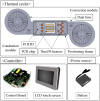Battery-operated portable PCR system with enhanced stability of Pt RTD
- PMID: 31247046
- PMCID: PMC6597155
- DOI: 10.1371/journal.pone.0218571
Battery-operated portable PCR system with enhanced stability of Pt RTD
Abstract
This paper reports an outdoor-use polymerase chain reaction (PCR) technology in which stability of resistance temperature detectors (RTDs) is remarkably improved. A thin-film RTD made of non-annealed Pt shows accuracy degradation because the resistance of the RTD tends to decrease during the PCR operation. Thus, the annealing process is applied to the Pt RTD to improve the stability, which is a prerequisite to the accurate measurement of the absolute temperature. Both heaters and the RTD are fabricated on a thin quartz substrate whose melting temperature is high enough for annealing. The performances in the PCR time and power consumption are enhanced by reducing the size of the heater chips with no degradation in the temperature uniformity. A spring-loaded electrode is employed to simplify the procedure of electrical connection to the thermal controller and loading/unloading of the PCR chip. The contact area of the electrical connection is so small that the conductive thermal resistance increases; thereby small heat dissipation can be exploited for low-power operation. The stability of the RTD is experimentally confirmed in terms of resistance variation over repeated PCR operations (four times). The least variation of 0.005%, which corresponds to a negligible temperature variation of 0.038 °C for the PCR, is achieved from the RTD annealed for 5 min at 450 °C. The gel-electrophoresis result indicates that the PCR performance of the proposed system using a film-type PCR chip is comparable to that of a conventional system using a vial tube despite its low power consumption.
Conflict of interest statement
The authors have declared that no competing interests exist.
Figures










Similar articles
-
Portable low-power thermal cycler with dual thin-film Pt heaters for a polymeric PCR chip.Biomed Microdevices. 2018 Jan 29;20(1):14. doi: 10.1007/s10544-018-0257-9. Biomed Microdevices. 2018. PMID: 29376193
-
Simply and reliably integrating micro heaters/sensors in a monolithic PCR-CE microfluidic genetic analysis system.Electrophoresis. 2009 Apr;30(8):1297-305. doi: 10.1002/elps.200800491. Electrophoresis. 2009. PMID: 19319907
-
Portable and Battery-Powered PCR Device for DNA Amplification and Fluorescence Detection.Sensors (Basel). 2020 May 5;20(9):2627. doi: 10.3390/s20092627. Sensors (Basel). 2020. PMID: 32380637 Free PMC article.
-
A review on microscale polymerase chain reaction based methods in molecular diagnosis, and future prospects for the fabrication of fully integrated portable biomedical devices.Mikrochim Acta. 2018 May 8;185(6):285. doi: 10.1007/s00604-018-2791-9. Mikrochim Acta. 2018. PMID: 29736588 Review.
-
The evolution of real-time PCR machines to real-time PCR chips.Biosens Bioelectron. 2010 Mar 15;25(7):1820-4. doi: 10.1016/j.bios.2009.11.021. Epub 2009 Nov 27. Biosens Bioelectron. 2010. PMID: 20022485 Review.
Cited by
-
A Thermocycler Using a Chip Resistor Heater and a Glass Microchip for a Portable and Rapid Microchip-Based PCR Device.Micromachines (Basel). 2022 Feb 21;13(2):339. doi: 10.3390/mi13020339. Micromachines (Basel). 2022. PMID: 35208463 Free PMC article.
-
Conductive Silver/Carbon Fiber Films for Rapid Detection of Human Coronavirus.Polymers (Basel). 2022 May 12;14(10):1983. doi: 10.3390/polym14101983. Polymers (Basel). 2022. PMID: 35631866 Free PMC article.
-
Seeking Solutions for Inclusively Economic, Rapid, and Safe Molecular Detection of Respiratory Infectious Diseases: Comprehensive Review from Polymerase Chain Reaction Techniques to Amplification-Free Biosensing.Micromachines (Basel). 2025 Apr 15;16(4):472. doi: 10.3390/mi16040472. Micromachines (Basel). 2025. PMID: 40283347 Free PMC article. Review.
-
Advances in Simple, Rapid, and Contamination-Free Instantaneous Nucleic Acid Devices for Pathogen Detection.Biosensors (Basel). 2023 Jul 14;13(7):732. doi: 10.3390/bios13070732. Biosensors (Basel). 2023. PMID: 37504131 Free PMC article. Review.
-
Review of methods for the detection of Lawsonia intracellularis infection in pigs.J Vet Diagn Invest. 2021 Jul;33(4):621-631. doi: 10.1177/10406387211003551. Epub 2021 Mar 19. J Vet Diagn Invest. 2021. PMID: 33739176 Free PMC article. Review.
References
Publication types
MeSH terms
Substances
LinkOut - more resources
Full Text Sources

